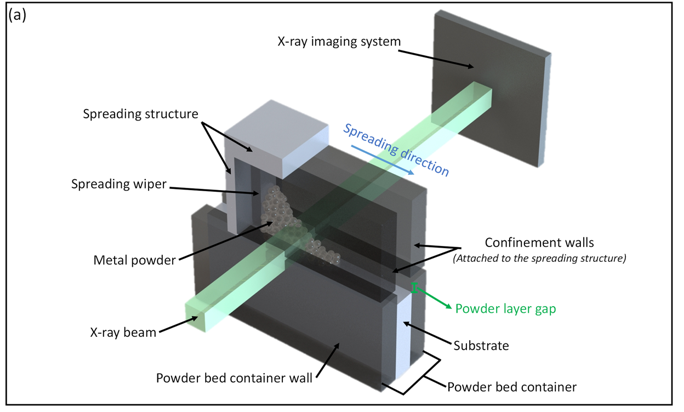Many things affect the quality of a finished 3D printed part, and in powder-based 3D printing, the spreading of the powder is a key step in determining how well the part will come out. In a study entitled “Revealing particle-scale powder spreading dynamics in powder-bed-based additive manufacturing processes by high-speed x-ray imaging,” a group of researchers studies the particle-scale dynamics of the powder spreading by using in situ high-speed high-energy x-ray imaging.
The researchers developed an experimental method in which they used high-speed high-energy x-ray imaging to characterize the powder spreading process with high spatial and temporal resolution and study the particle scale spreading process in-situ. With this method, they revealed the evolution of the repose angle, the slope surface flow speed, and slope surface roughness during the powder spreading process.
“We observed and analyzed the evolution and flow of two different types of powder clusters on the slope surface, and closely examined the particles that formed such clusters,” the researchers state. “We analyzed the dynamic interaction of individual particles with their respective boundaries and calculated coefficients of friction between the powders and boundaries.”
They developed a powder spreading system to simulate the spreading process under additive manufacturing configurations. The system consisted of a spreading structure (wiper and confinement walls) and a powder bed container. The wiper was made from an aluminum blade that was perpendicular to the powder bed substrate. Confinement walls, designed to keep the powder inside the spreading system, were made from high-density graphite and attached to either side of the blade.
“Powders are spread by an aluminum wiper (blade) at a spreading speed of 11.5 mm/s on an aluminum substrate,” the researchers explain.
“As the powder is spread, an x-ray beam passes through the powder bed, and the x-ray signal is recorded by a detection system. The exposure time is 500 ns. A camera is set to record at a speed of 10,000 frames per second and an analysis of the images is done using the Image9.”
They used two different diameters of 316 L stainless steel powder. Eight samples were extracted and analyzed for each type of powder; the samples were carefully spread over a glass substrate and then images were obtained using an optical microscope.
Several conclusions were reached by the experiment:
- The average powder size is an important parameter that affects powder flow dynamics during the spreading process. The powder with a larger average diameter showed a higher average dynamic repose angle, as well as a higher average surface flow speed, than the powder with a smaller average diameter.
- Powder clusters affect powder spreading behavior. The powder clusters could not easily flow through the slope surface.
- Interactions of powders with boundaries were characterized and the coefficients of friction were calculated. The calculated kinetic coefficients of friction were 0.25 for particles moving over an aluminum substrate, and 0.18 for particles moving over a high density graphite surface.
“The particle-scale powder spreading dynamics revealed are important for understanding powder spreading behavior in the powder-bed-based additive manufacturing process,” the researchers conclude. “This is critical for the development and validation of more accurate models for predicting powder spreading behavior.”
Authors of the paper include Luis I. Escano, Niranjan D. Parab, Lianghua Xiong, Qilin Guo, Cang Zhao, Kamel Fezzaa, Wes Everhart, Tao Sun and Lianyi Chen.
Discuss this and other 3D printing topics at 3DPrintBoard.com or share your thoughts below.
